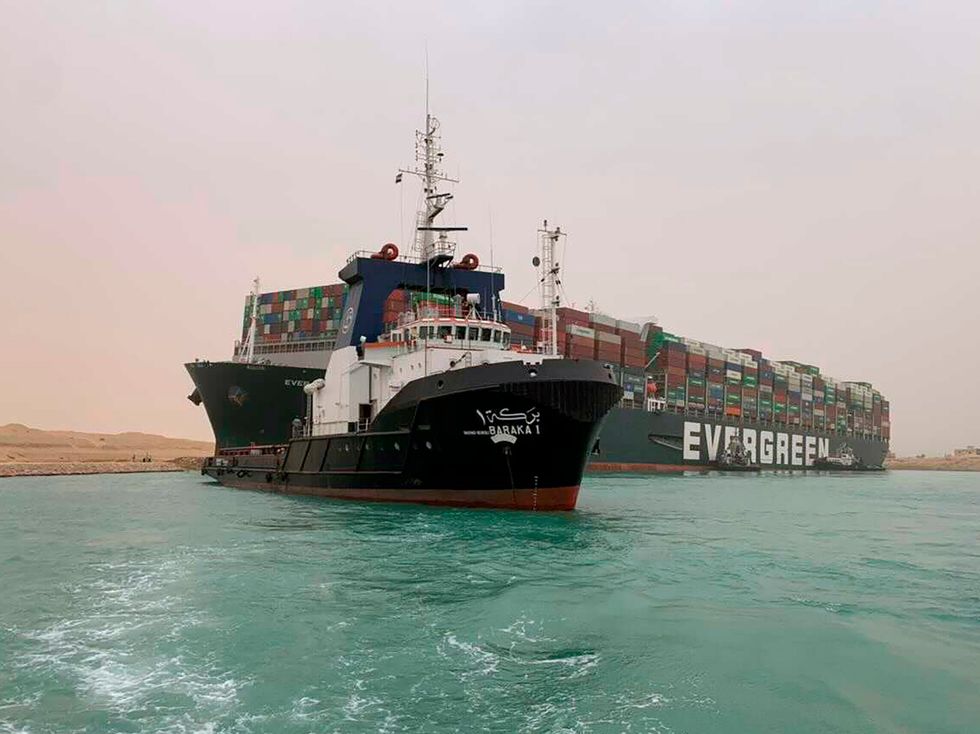News
Harriet Brewis
Mar 25, 2021
The giant container ship lodged in Egypt’s Suez Canal is finally free.
The skyscraper-sized Ever Given ran aground on Tuesday, halting global trade through one of the world’s most vital waterways.
The log-jam left more than 350 vessels carrying goods to ports across the globe trapped at both ends of the canal, which links the Red Sea to the Mediterranean.
But finally, on Monday, a flotilla of tugboats managed to wrench the 220,000-ton vessel from the canal’s sandy bank.
So how did one of the world’s largest cargo ships manage to run aground? And what did it take to set her back on her way? Here’s what photos and maps can tell us about the whole saga...
Read more:
- Wendy’s chicken sandwich nightmare sparks fierce TikTok debate
- Priti Patel gets the meme treatment after Home Office spends £77,000 on eyebrows
- The key people moving to GB News and who else is rumoured to be joining them
- These maps and images show exactly what went wrong with Ever Given in the Suez
Tuesday morning: The Ever Given gets stuck
The Ever Given was headed for Rotterdam in the Netherlands, from the Yantian district of China, according to the tracking site Vessel Finder.
A map of the ship’s trajectory shows that she took a meandering (and unfortunate-looking) route before entering the canal.
Forty-five minutes after entering the shallow channel, at around 7.45am local time, she ran aground.
Here’s a satellite view of the behemoth lodged across the thin body of water:
How did it happen?
The ship’s operator and Egyptian officials have blamed winds gusts of up to 50km per hour (30 miles per hour), along with a sandstorm sweeping the area.
Some have wondered if the ultra-large size of the Ever Given – which measures 400m-long by 59m-wide – was a factor.

While the supersize of ships can increase their risk of running aground in the Suez Canal, boats just as big buffeted by winds just as strong have passed through the waterway without incident before.
Some professional observers have suggested that the design of the ship’s bow — a large, bulbous prong embedded in the bank of the canal — could have contributed to the issue.
Meanwhile, a worker on board another ship, the Maersk vessel MV Denver, suggested the Ever Given had cut in line as other vessels made their way into the Suez.
The alleged mariner wrote in an Instagram post: “I believe they cut us off this morning entering the canal and then this happened and right after they ran aground.”
How have the authorities responded?
A fleet of boats were hauled into action on Wednesday in a bid to drag the Ever Given to deeper waters.
Satellite images and virtual recreations show her surrounded by the valiant tugs:
Here is a view of one such helper boat, in front of the Ever Given, provided by the Suez Canal Authority on Wednesday:
Thursday: Calling in outside help
Dutch engineering company Boskalis – experts in boat-related disasters – joined the efforts to free the ship on Thursday morning.
CEO Peter Berdowski summed up the problem with the Ever Given: "It is like an enormous beached whale. It’s an enormous weight on the sand.”
To lighten the load, the team warned that they may have to remove at least some of her containers and drain the vessel of the water before further trying again to nudge the ship using tugboats.

Officials had indicated initially they didn’t want to do that because the unloading itself could take days or weeks.
Berdowski said: "We might have to work with a combination of reducing the weight by removing containers, oil, and water from the ship; tugboats; and dredging of sand.”
This picture released by the Suez Canal Authority offered some insight into the challenges faced by the salvage team:

Friday: Big words but little sign of movement
On Friday, the Ever Given’s Japanese owner, Shoei Kisen, announced that it aimed to free the ship "tomorrow night Japan time", according to the Nikkei.
However, a spokeswoman for the firm said that whilst refloating work was ongoing, they didn’t yet know when the efforts would bear fruits.
"We don’t have an estimate for when the work will succeed," she said.
Satellite footage suggested the ship was still very much locked in place:
Meanwhile, an Egyptian official at the Suez Canal Authority described the work as complex and said those trying to dislodge the vessel wanted to avoid complications that could extend the canal closure.
The rescue efforts focused on dredging to remove sand and mud from around the port side of the vessel’s bow.
The Suez Canal Authority, which operates the waterway, deployed tugboats and a specialised suction dredger that is able to shift 2,000 cubic metres of material every hour.
The authority estimated that it would need to remove between 15,000 to 20,000 cubic meters (530,000 to 706,000 cubic feet) of sand to reach a depth of 12 to 16 metres (39 to 52 feet).
This map broke down the task ahead:
Monday: ‘We pulled it off!’
On Monday morning it emerged that the Ever Given had been partially refloated. This followed intensive efforts to push and pull the ship with 10 tugboats when the full moon brought spring tide, raising the canal’s water level.
Videos shared widely on social media showed tugboats in the canal sounding their horns in celebration of the Ever Given being partly wrenched from the shore:
After hauling the fully laden 220,000-ton vessel over the canal bank, the salvage team began pulling the vessel toward the Great Bitter Lake – a wide stretch of water halfway between the north and south end of the canal – where she will undergo technical inspection, canal authorities said.
Satellite data from MarineTraffic.com confirmed the ship was moving away from the shoreline toward the centre of the artery.
This video released by the Suez Canal Authority showed the Ever Given being escorted by the tugboats that helped free it, each sounding off their horns in jubilation after nearly a week of chaos:
"We pulled it off!" Berdowski rejoiced in a statement.
"I am excited to announce that our team of experts, working in close collaboration with the Suez Canal Authority, successfully refloated the Ever Given ... thereby making free passage through the Suez Canal possible again."
What happens next?
It remains unclear when traffic through the canal will return to normal, with data firm Refinitiv estimating that it could take more than 10 days to clear the backlog of ships, filled with everything from livestock to oil, and flat-pack furniture to erotic toys..
Meanwhile, dozens of vessels have opted for the alternate route around the Cape of Good Hope at Africa’s southern tip – a 3,100-mile detour that adds some two weeks to journeys and costs ships hundreds of thousands of dollars in fuel and other costs.
It is also not clear whether the Ever Given will continue to its original destination of Rotterdam or if it would need to enter another port for repairs.
Why was it all so significant?
More than 10 per cent of global trade, including seven per cent of the world’s oil, passes through the canal.
In the wake of the block, the price of international benchmark Brent crude shot up by around three per cent to $63 a barrel.
The closed waterway held up $9 billion in global trade each day the canal was closed, at a time when the coronavirus pandemic is already causing demand in consumer goods to surge.
This graphic shows how the block has impacted traffic through the canal:
Shipping giant Maersk forecasts the impact of the backlog will take months to work through global supply chains. Beyond that, a multi-million-pound legal battle will soon kick off. Experts say it could easily take five years to resolve.
The jam has also prevented the return of empty containers back to Asia, exacerbating a container shortage caused by the pandemic’s disruptions to shipping.
Ship operators have not yet offered a timeline for the reopening of the crucial canal.
But, for now, all that can be said is godspeed to the Ever Given. Here’s hoping the next leg of her journey runs a lot more smoothly.
More: Do large corporations need to be more open about their energy consumption and how it is sourced?
Top 100
The Conversation (0)


















